
views
Drafting an Answer

Read the summons and complaint carefully. When you're served with a summons and complaint, typically a sheriff's deputy or private process server will come to your home or place of work and hand you the court papers. Try to remain calm as you sit down and open the papers to read them. The summons tells you how to answer the lawsuit and how long you have to file your response with the court. It will likely advise that the plaintiff (the debt collector) can get a default judgment against you if you don't respond. The complaint provides information about the debt collector that is suing you, the name of the original credit card company, and the amount of money they claim you owe.

Gather any documents you have related to the debt. If you recognize the information in the complaint, search your records for any documents that are related to the original debt or any collection attempts. These records will help you decide how you want to respond to the lawsuit. For example, you may be able to find the last statement you received from the credit card company or a letter from a collection agency. If any of the information in your own documents doesn't match the information in the complaint, you may have a defense to the lawsuit.

Meet an attorney for an initial consultation. Most attorneys who specialize in debt collection lawsuits offer a free initial consultation. Even if you don't have the funds to hire an attorney to represent you in court, it's worth taking advantage of a free consultation. The attorney can look at the complaint and your records and advise you on defenses you may be able to use or tell you how to respond to the lawsuit. To find an attorney, search online for your state's bar association, then click through to the referral service. These services are free and will provide you with the name of a local attorney based on your answers to a few questions. Bring your summons and complaint with you to the meeting, along with any documents you have that are related to the debt. If the attorney's fees are going to be more than the amount the debt collector is saying you owe, it might not be worth it to hire an attorney, even if you can afford their fees. Unless you know that the debt is not yours, you'd probably be better off simply settling the debt.

Look for forms you can use. Most courts have blank answer forms that you can use to format your response to the summons and complaint. The name of the court will be at the top of the summons. Search for that name online to find the court's website. Then, search for forms that you can download. Some courts include a blank answer form along with the summons and complaint. If you got one of these forms, you can simply fill it out by hand.Tip: If you can't find any forms, take a trip to the clerk of court's office and ask for a copy of an answer filed in another debt collection lawsuit. You can use that as a guide to format your own answer.
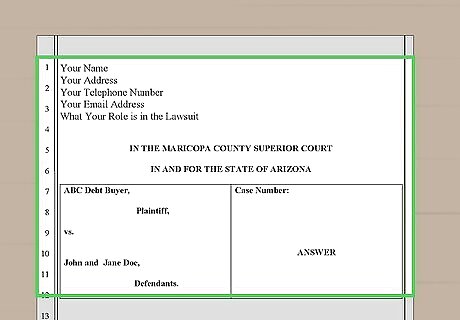
Copy the caption from the complaint. The lines at the top of the complaint are called the "caption" and identify the plaintiff and defendant in the case, as well as the unique case number assigned by the court. Copy this information onto your answer exactly as it appears on the complaint. If your name is spelled incorrectly, do not correct it. Copy the incorrect spelling in your caption. You may be able to use this as a defense that you are not the person named.
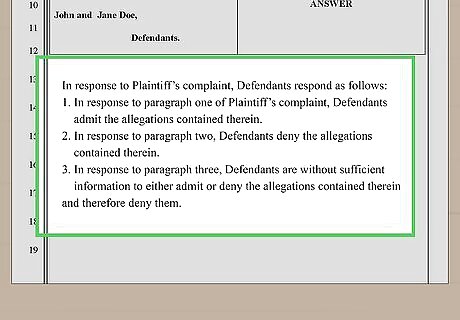
Write your responses to the statements in the complaint. The complaint has a series of numbered statements or allegations. In your answer, address each statement by number and state whether you affirm or deny that statement. Typically, the first couple of statements identify you by name and address. If these are correct, it's safe to go ahead and affirm those statements. However, if any of this information is incorrect or your name is spelled wrong, go ahead and deny them. Deny the rest of the statements, even if you recognize the debt and can verify all of the information in your own records. Denying the statements forces the debt collector to prove the allegations with factual evidence. If they don't have evidence to back up those claims, they may lose the lawsuit against you.Tip: Denying an allegation in an answer doesn't mean that you're claiming the allegation is false. Rather, you're essentially telling the debt collector to prove it. The debt collector has the burden of proof — make them meet it.

Assert any defenses that apply for you. In addition to denying the allegations in the complaint, you can also list any defenses that you think might apply in your case. Include any that you think might apply, even if you're not sure. You don't necessarily have to argue all of the defenses you list in court, but if you don't include them in your answer, you may not be able to raise them later. Some common defenses in debt collection cases are: Plaintiff is asking for the wrong amount of money. Use this if the complaint alleges that you owe a different amount than your records show you do. Plaintiff waited too long to bring this case. If the debt is several years old, the debt collector may no longer have the right to sue you for it. Each state has a statute of limitations, ranging from 3 to 10 years, that governs how long a debt collector has to sue on a debt after the last payment. You don't have a business relationship with the plaintiff. Use this if the plaintiff is a collection agency and you've never signed a contract with them. This defense forces them to prove that they have the right to collect the money.Tip: Depending on the circumstances of your case, there may be other defenses you could use. An attorney can tell you which defenses you should raise.
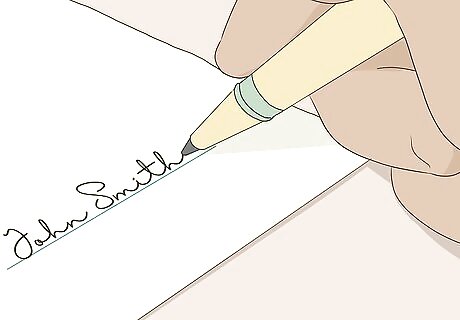
Print and sign your answer. Once you've finished your answer, look it over carefully to make sure there aren't any typos or other mistakes. If you typed it on a computer, print it so you can sign it with a blue or black ink pen. Since you are not an attorney, some courts require you to sign court documents in the presence of a notary. If the form you use includes a notary block, don't sign it until you're in front of a notary. Take a valid, government-issued photo ID with you so the notary can verify your identity.
Filing Your Answer
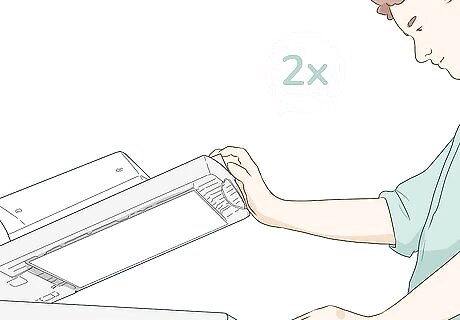
Make at least 2 photocopies of your signed answer. After you've signed your answer, make a photocopy to keep for your records and a photocopy to send to the plaintiff (or their attorney). Some courts may require additional copies. It's a good idea to call the clerk's office and find out how many copies you'll need. While the clerk may be willing to make additional copies for you, they'll likely also charge you a fee for this service.

Take your answer to the clerk's office. The address of the courthouse is listed on your summons and complaint. If it's a large courthouse and you don't know your way around, ask the security guard at the entrance where the clerk's office is. Typically, it will be near the main entrance to the courthouse. Tell the clerk that you want to file an answer in your case. Give them the originals and your photocopies. They will stamp the first page of each and give the photocopies back to you. The originals are for the court's records. You typically don't have to pay a filing fee to file an answer, but in some courts you do. If there's a filing fee, it's usually no more than $20 or $30. If you have a low income or are receiving government benefits, you may be able to get the fees waived.Tip: You may need to fill out other paperwork, such as a Notice of Appearance (if you're representing yourself). Typically, the clerk can give you these forms and you can fill them out there.

Deliver one of the copies to the plaintiff or their attorney. The address of the plaintiff or their attorney is listed on your summons. Go from the courthouse directly to the post office. Mail one of the file-stamped photocopies to the address listed on the summons. Send your answer using certified mail with return receipt requested so you'll know when your answer is received. You'll need this information to prove to the court that the plaintiff got your answer.
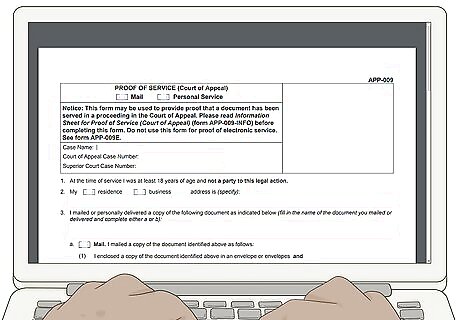
Fill out a Certificate of Service. You can pick up a Certificate of Service form at the clerk's office or download it from the court's website. Copy the caption from the case exactly as it appears on the complaint, then fill in the information to indicate how you sent your answer to the plaintiff. Attach the green card you got back from the certified mail to the form (after you've made a copy of both for your records). This proves that the plaintiff received your answer. Some courts require you to file this form with the clerk's office. In others, you merely keep it until the first court date. The clerk can tell you what you need to do after you've sent a copy of your answer to the plaintiff.
Reaching a Settlement

Decide if you want to settle the debt. In some circumstances, it makes more sense to settle the debt than to go to court and try to fight the lawsuit. Settlements give you more control over the outcome. If you lose the lawsuit, you may not have much choice in how you pay the debt back. Seeking a settlement is a good idea if: You recognize the debt and can verify the amount listed in the complaint. You made the last payment on the debt within the last year or two. You have enough money to pay off the debt, either all at once or over time.
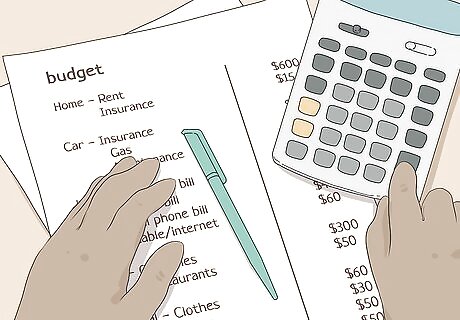
Create a budget to determine payments you can afford. Gather information about your income and expenses and figure out how much money you have left each month. If there isn't enough to make a reasonable payment, look at where you can possibly cut expenses to help you pay back the debt. A reasonable payment depends on the amount you owe and how long you've owed it. For example, if you only owe $500, the debt collector may be willing to accept $100 a month. However, if you owe $5,000, it's unlikely that the debt collector will consider $100 a reasonable payment amount given how long it would take you to pay back the debt. Most debt collectors prefer the fewest number of payments possible. They believe you're less likely to complete a payment plan if there are several years of payments involved.Tip: Come up with several different scenarios that would work with your budget. That way, you'll have multiple options to offer the debt collector.

Call the debt collector with a low-ball offer. Let the debt collector know that you'd like to arrange a settlement. They may already have an offer (or several) prepared for you to consider. If they do, write these down and compare them to the options you worked out after looking at your budget. Be prepared to haggle. For example, suppose the debt collector says they will settle your $1,000 debt for a lump-sum payment of $750. You might counter that you can do a lump-sum payment of $500. They may take your offer, or they may counter again. Start low, but not so ridiculously low that you don't sound serious. If you offer something unreasonable, the debt collector might hang up on you. For example, if you owe $1,000, it would be unreasonable to offer to settle for $100.Tip: If you can make a lump-sum payment immediately for all or a substantial portion of the debt, talk to the debt collector before you file your answer. You may be able to reach a settlement without having to file an answer at all. However, if the deadline is within a few days and you still haven't reached a settlement, go ahead and file an answer.

Negotiate with the debt collector to reach a settlement. These conversations typically go through several rounds of offers and counter-offers. It's highly unlikely that the debt collector will accept your low-ball offer. Likewise, you shouldn't accept the debt collector's initial offer either — it's certainly not the best they can do. If you feel comfortable, you might want to throw in a sob story in an attempt to gain some sympathy. It probably won't work (debt collectors have typically heard it all, and they have a reputation for being unforgiving), but it's worth a shot, particularly if you've been going through rough times lately. Debt collectors frequently use high-pressure tactics to get you to settle at the highest possible amount. Keep your budget and figures in front of you so you don't get pressured into agreeing on an amount that you can't afford to pay.Tip: If you're not having any luck with the debt collector, or if they refuse to negotiate with you, try calling the attorney listed on their complaint.

Get the settlement agreement in writing. If you are able to reach an acceptable settlement with the debt collector over the phone, have them send you a letter that outlines the terms of that agreement. Don't make any payments to the debt collector until you've received this letter. Take notes of the specific terms of the settlement agreement while you're on the phone. Read your notes back to the debt collector to verify that your information is correct. It also doesn't hurt to record the phone conversation if you have the means to do so. When you get the letter from the debt collector outlining the settlement, compare it to your notes (or to the recording, if you recorded the call). If any of the terms don't match the original agreement, call the debt collector and let them know.

Confirm that the debt collector has withdrawn the lawsuit. After you've reached a settlement and have a written agreement, the debt collector's attorney should withdraw their lawsuit. However, sometimes they don't. Call the clerk's office to verify that the case is no longer on the docket. If the attorney has failed to withdraw the lawsuit, call the attorney's office. Tell them that you and the debt collector have reached a settlement in the case and they need to pull the case from the court's docket. Then, call the clerk's office back to confirm.


















Comments
0 comment